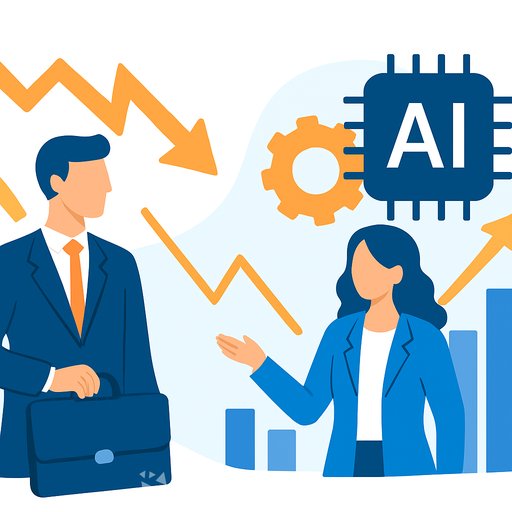Amazon's AI Strategy Behind Job Cuts: Building for Speed, Ownership, and Scale
Amazon plans to cut about 14,000 corporate roles - roughly 4% of its 350,000 corporate employees. Leadership is clear: this isn't simply cost-cutting. It's a structural bet on AI, with resources moving to the systems, talent and operating model that will matter most over the next decade.
As Senior Vice President Beth Galetti put it, the company needs to be "organised more leanly" with "fewer layers and more ownership" to move at AI speed. The goal: a stronger, faster Amazon that reallocates spend and attention toward its biggest AI opportunities.
The strategic logic
- Capital shifts to AI infrastructure: Up to US$118bn in capex this year, largely for new data centers and AI chips - including support for Anthropic, where Amazon has invested US$8bn.
- Fewer layers, higher ownership: Streamlined management to operate "like the world's largest startup," prioritizing speed and direct accountability.
- Office-first to increase throughput: The return-to-office move aims to raise the ratio of individual contributors to managers and accelerate decision-making.
- Role mix changes: Some jobs sunset; new roles appear around AI engineering, model operations, data platforms and AI product management.
"Speed is a leadership decision"
CEO Andy Jassy has been explicit: speed is a choice, reinforced by structure and culture. "The leadership team has to believe it's a priority, reinforce it constantly, organise and remove structural barriers and build in modular ways that enable pace."
He adds that Amazon operates like "the world's largest startup" because it continually prioritizes customers, delivery, invention, ownership, speed, scrappiness and curiosity. "It remains Day One."
What this signals for operating models
- Lean spans and layers: Flatter orgs reduce decision latency and improve cycle time from idea to deployment.
- Product-centric teams: Small, accountable teams with clear P&L or mission ownership, shipping in short increments.
- Modular architecture: Build systems that can be upgraded piece by piece as AI models and chips evolve.
- Partner ecosystems: Strategic investments (e.g., Anthropic) to secure compute, models and ecosystem leverage.
Workforce design implications
- Role reassignment: Fewer coordination roles; more builders and operators (AI engineers, MLOps, data reliability, platform SRE, privacy and risk).
- Manager tilt: Fewer layers, broader spans; managers become coaches who unblock, not traffic-cop coordinators.
- In-office collaboration: Faster alignment, ad hoc problem-solving and higher feedback frequency for technical work.
- Reskilling track: Practical upskilling in applied AI, prompt design, data quality and product-led delivery.
Capital allocation and AI infra
Large-scale AI requires sustained capex in GPUs/TPUs, data centers, networking, storage and energy. The payoff is lower unit cost per inference and faster iteration loops - if utilization stays high.
- Key trade-offs: vendor concentration risk, chip supply constraints, energy availability, data gravity and latency.
- Mitigations: multi-vendor chipset strategy, capacity reservations, efficiency work (quantization, distillation), and model routing for cost-safe performance.
Execution playbook for executives
- Org audit (30-45 days): Map spans/layers; identify decision bottlenecks; quantify cycle time from idea to production.
- De-layer and rebundle: Shift work into product pods with clear owners and metrics; sunset redundant coordination work.
- AI portfolio: Prioritize 5-7 high-ROI use cases tied to cost-to-serve, throughput or revenue lift; kill low-signal experiments.
- Capex governance: Tie compute budgets to model KPIs (quality, latency, cost per 1K tokens/inferences) and utilization thresholds.
- Platform first: Build shared data and model-serving platforms; standardize security, privacy and monitoring.
- Talent plan: Hire for AI engineering, MLOps and data reliability; reskill top performers; exit low-leverage layers.
- Office rhythms: Short standups, weekly demo days, monthly product reviews; decisions logged with clear owners and deadlines.
- Risk and compliance: Model governance, bias testing, data lineage, human-in-the-loop checkpoints for critical flows.
Metrics that matter
- Speed: Lead time (idea to deploy), decision latency (issue to decision), deploy frequency, MTTR.
- AI economics: Cost per inference/1K tokens, GPU utilization, model win rate vs. baseline, percent of workloads on shared platforms.
- Org health: Span/layer ratios, manager/IC ratio, internal mobility, time-to-productivity for AI roles.
- Business outcomes: Cost-to-serve reduction, conversion/uplift from AI features, revenue from AI-enabled offerings.
Risks and counterbalances
- Morale and retention: Layoffs can trigger brain drain. Counter with transparent rationale, growth paths and meaningful upskilling.
- Over-centralization: Central platforms are efficient but can slow teams. Offer paved roads, not gates.
- Model risk: Drift, bias and hallucinations require monitoring, evaluation datasets and rollback plans.
- Vendor lock-in: Hedge with multi-cloud abstractions, open formats and portability standards.
The bigger picture
Analysts see Amazon's move as part of a broader pattern: as AI tools advance, big tech is redistributing work and flattening organizations. The through line is consistent - fewer layers, faster ships and heavier AI investment to set the growth curve for the next decade.
The lesson for leaders is simple: choose speed, fund the platforms, and structure for ownership. Everything else is noise.
Next steps for your team
- Pick three AI use cases tied to hard dollars; define owners, guardrails and go-live dates.
- Consolidate overlapping management layers; move top talent into product pods with clear KPIs.
- Stand up a model operations stack with observability, cost controls and evaluation harnesses.
If you're retooling roles for AI delivery, here's a curated list of programs by function: AI courses by job.
Your membership also unlocks:






